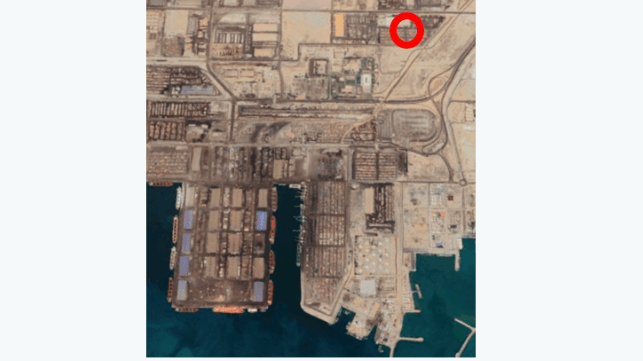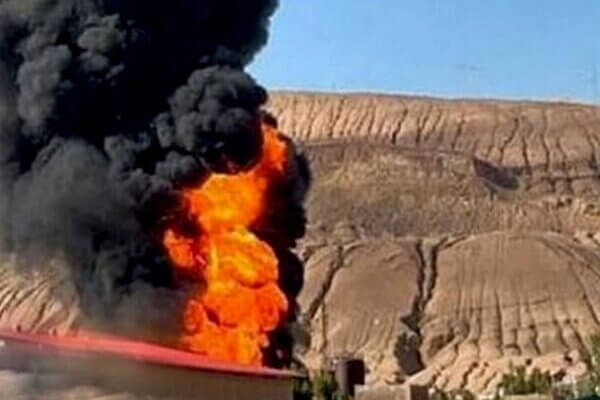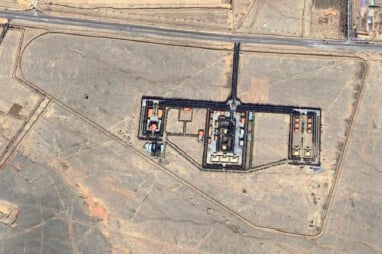Port Operations in Bandar Abbas, Iran Remain Heavily Disrupted

Iran’s clerical leaders are attempting to suppress discussion in Iran on the causes of the explosion in Bandar Abbas port on April 26. The official narrative pushes the idea that the explosion was caused by a safety breach in handling hazardous material. Officials are also claiming the port is getting back to normal, given that cranes and container handling material on the operational quays were not directly impacted by the blast.
Saeed Rasouli, Deputy Minister of Transport and Head of the Ports and Maritime Organization, claimed that since the disaster 26 ships have been turned around in the port. The Vessel Finder website reports that “39 vessels have arrived within the past 24 hours and that 15 ships are expected to arrive in the next 30 days.” The Minister also insisted that damage was confined to a 15-hectare area of the container yard. Warnings have been issued to Iranian media not to query this official line.
Iran’s reformist President Masoud Pezeshkian, often at variance with the clerical and IRGC leadership, is however taking a different course, demanding a thorough and transparent investigation into the causes of the explosion. He has also focused on the victims of the disaster, appreciating the risks that those with grievances could spark wider social unrest.
On social media, port workers have commented that as many as 300 may have been killed in the explosion, at variance with the official figure of 70 because of the number of undocumented and illegal workers who were employed in the container yards, and because no trace remains of many of those who are still missing. With so many workers injured, and with administrative buildings and transport infrastructure damaged, a return to normal working is likely to be some way off.
Analysis from satellite imagery of the fire and blast damage has revealed that the seat of the explosion, marked by a substantial crater, was in the container yard belonging to Sina Marine and Port Services, immediately adjacent to the administrative offices of the company. These offices, along with all traces of the workers within, have completely disappeared.
The company is controlled by the Mostazafan Foundation, one of numerous quasi-charitable entities in Iran that are directly controlled by the Supreme Leader and are otherwise independent of government control, an arrangement whose purpose is to ring-fence the revenues earned for funding the Islamic Revolutionary Guard Corps (IRGC). The Mostazafan Foundation is sanctioned by the United States. The hazardous materials compound, which government hardliners are claiming was the seat of the explosion, appears to be undamaged and lies 1400 yards northwest of ground zero in the Sina container storage area.
The hypothesis that the explosion was of the ammonium perchlorate shipped from China has been further reinforced by the reddish color of the mushroom cloud, attributable to nitrogen dioxide which is a byproduct of the combustion of ammonium perchlorate. In the immediate aftermath of the explosion members of the IRGC sought to remove particular containers which had not been immediately damaged.

The aftermath of the explosion at the Ava Nar Parsian Chemical Industries factory (Mehr News Agency)
In the meantime, there has been another explosion, this time in a factory in Isfahan Province which has previously been associated with the Iran Aircraft Manufacturing Industrial Company (HESA). HESA is a U.S.-sanctioned entity, being one of Iran’s two principal drone manufacturers.
The explosion in the Ava Nar Parsian Chemical Industries' factory in Isfahan Province occurred on the morning of April 29 and killed two workers.

The Ava Nar Parsian Chemical Industries factory In Isfahan Province at 32.9920N 51.4062E (Google Earth) previously known as the Nargostar Sepahan Chemical Industry Complex
Four years ago, the Jerusalem Post reported on May 23, 2021, that the site had suffered an explosion that injured nine people. The site, previously known as the Nargostar Sepahan complex, is believed to manufacture the integrated warheads built into the HESA-manufactured drones. The Jerusalem Post implied that the 2021 explosion was a reprisal attack, a response to the interception the previous week of a drone launched from Iraq, which Prime Minister Benjamin Netanyahu claimed had been Iranian.
Neither the damage caused at the port in Bandar Abbas, nor the explosion at the HESA/Nargostar site, are likely to be more than temporary setbacks for Iran’s drone manufacturing program. The underlying intention behind the events is likely to be political, designed to influence the current dialogue ongoing between Iran and the United States so as to ensure that any agreement also includes curbs on Iranian drone and missile manufacture.
It was announced on Thursday, May 1, that the fourth round of talks between the United States and Iran scheduled for Rome with the Omanis as the facilitators have been delayed. Iran cited "logistical and technical reasons" for the postponement, but tensions have been rising as the U.S. imposed further sanctions, including on the network that it says facilitated the shipment of the making of the missile propellant.
The opinions expressed herein are the author's and not necessarily those of The Maritime Executive.
